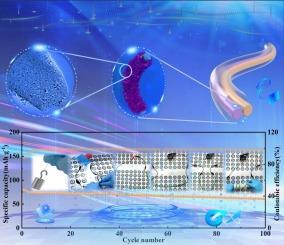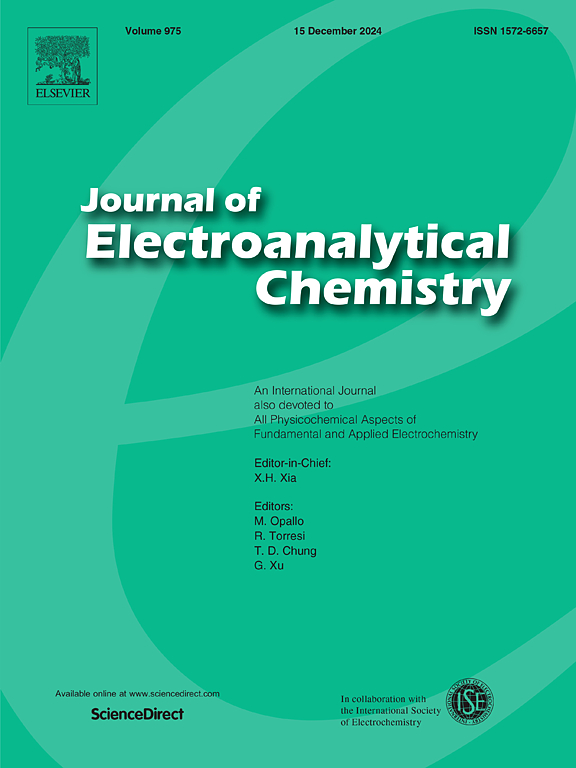MOF-derived Na3V2(PO4)3-carbon@graphene fibers for flexible fiber-shaped sodium ion battery
IF 4.1
3区 化学
Q1 CHEMISTRY, ANALYTICAL
引用次数: 0
Abstract
With the growing popularity of wearable devices, fiber-shaped rechargeable batteries become increasingly important as the next-generation energy storage devices. However, the practical applications are hindered by the limitation of sluggish kinetics of the Na+ transport and poor conductivity. Herein, a novel composite fiber was designed and fabricated as a cathode material for fiber-shaped Na-ion batteries (SIBs). The unique architecture on the fiber surface has three-dimensional porous structure, numerous channels for Na+ and electron transport, that facilitates electrolyte infiltration and strain-relaxed substructure. Na3V2(PO4)3 nanoparticles are uniformly incorporated into carbon matrix. The as-prepared fiber shows improved conductivity, accelerated Na+ diffusion kinetics and enhanced mechanical properties. The resulting composite fiber achieves a reversible specific capacity of 57.1mAh g−1 after 1000 cycles with 86.0 % capacity retention and exhibited a superior rate capability via half-cells. Furthermore, the fiber-shaped full SIBs were also fabricated, which present a reversible capacity of 18.2 μAh cm−1 at different bending angles. The full batteries exhibit excellent rate performance, stable cycling capability, and outstanding flexibility. This work may provide new insights into fiber-shaped SIBs for actual wearable applications.

用于柔性纤维状钠离子电池的 MOF 衍生 Na3V2(PO4)3-carbon@graphene 纤维
随着可穿戴设备的日益普及,纤维状可充电电池作为下一代储能设备变得越来越重要。然而,Na+传输动力学缓慢和导电性差等限制因素阻碍了其实际应用。在此,我们设计并制造了一种新型复合纤维,作为纤维状纳离子电池(SIB)的阴极材料。纤维表面的独特结构具有三维多孔结构、大量的 Na+ 和电子传输通道,有利于电解质渗透和应变松弛子结构。Na3V2(PO4)3 纳米粒子均匀地融入碳基质中。制备的纤维具有更好的导电性、更快的 Na+ 扩散动力学和更强的机械性能。所制备的复合纤维在 1000 次循环后的可逆比容量达到 57.1mAh g-1,容量保持率为 86.0%,并通过半电池表现出卓越的速率能力。此外,还制作了纤维状全 SIB,在不同弯曲角度下的可逆容量为 18.2 μAh cm-1。这种全电池具有优异的速率性能、稳定的循环能力和出色的柔韧性。这项工作可能会为纤维状 SIB 在实际可穿戴应用中的应用提供新的见解。
本文章由计算机程序翻译,如有差异,请以英文原文为准。
求助全文
约1分钟内获得全文
求助全文
来源期刊
CiteScore
7.80
自引率
6.70%
发文量
912
审稿时长
2.4 months
期刊介绍:
The Journal of Electroanalytical Chemistry is the foremost international journal devoted to the interdisciplinary subject of electrochemistry in all its aspects, theoretical as well as applied.
Electrochemistry is a wide ranging area that is in a state of continuous evolution. Rather than compiling a long list of topics covered by the Journal, the editors would like to draw particular attention to the key issues of novelty, topicality and quality. Papers should present new and interesting electrochemical science in a way that is accessible to the reader. The presentation and discussion should be at a level that is consistent with the international status of the Journal. Reports describing the application of well-established techniques to problems that are essentially technical will not be accepted. Similarly, papers that report observations but fail to provide adequate interpretation will be rejected by the Editors. Papers dealing with technical electrochemistry should be submitted to other specialist journals unless the authors can show that their work provides substantially new insights into electrochemical processes.

 求助内容:
求助内容: 应助结果提醒方式:
应助结果提醒方式:


